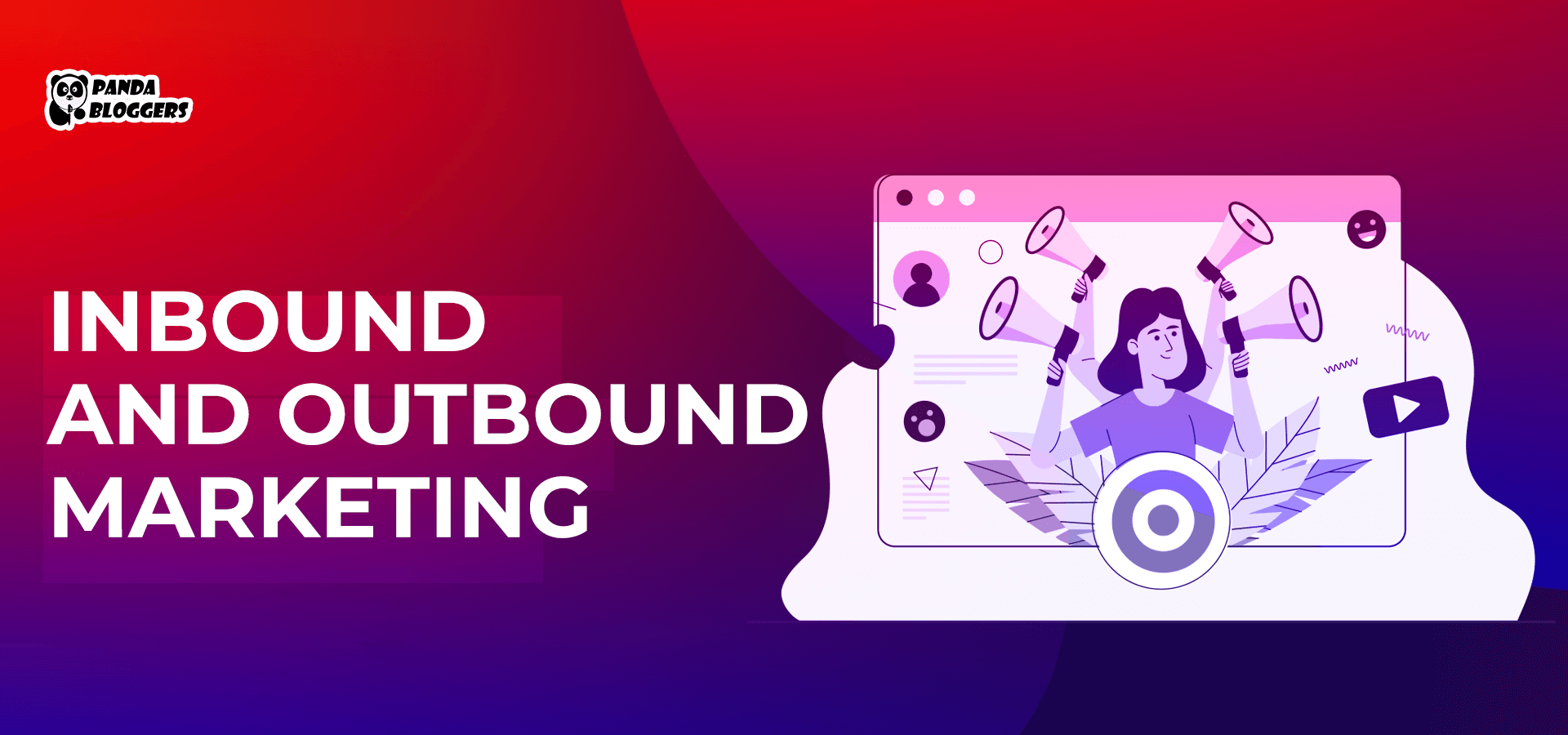
7 Reasons Why Modern Businesses Combine Inbound and Outbound Marketing
The customer acquisition and demand generation strategies implemented by businesses can be divided into two broad categories – inbound marketing and outbound marketing. Inbound marketing strategies focus on attracting and engaging customers through the creation of useful content and experiences. Inbound marketers attract, engage, and influence customers by delivering relevant and valuable content.
On the other hand, outbound marketing emphasizes brands reaching out to potential customers directly. Outbound marketers initiate contact with prospects or leads using traditional marketing methods like direct mail, cold calling, cold emails, and tradeshow presentations. Hence, inbound and outbound marketing differ from one another in many aspects – approach, goal, methods, and costs.
In a previous blog, I have already highlighted the key differences between inbound and outbound marketing. Most companies and startups these days do not consider inbound marketing as a new-age alternative to outbound marketing. They have been driving customer acquisition and demand generation by combining inbound and outbound marketing methods. In this blog post, let’s discuss what makes modern businesses and startups combine inbound and outbound marketing methods.
7 Reasons Why Modern Businesses Combine Inbound and Outbound Marketing
Increase Lead Generation Sources
Inbound marketers usually generate leads using top digital marketing channels like websites, search engines, social media, and chatbots. At the same time, outbound marketers generate leads by implementing strategies like targeted cold mail, cold calling, referral programs, and industry events. Hence, inbound and outbound marketers generate leads using different channels and strategies.
Integration of inbound and outbound marketing helps businesses generate more leads. For instance, outbound marketers can connect and engage with leads that do not interact with the content distributed by the brand. They can foster relationships with such leads while attending seminars, conferences, and similar in-person events. Likewise, inbound marketers can engage with professionals who do not attend in-person events regularly due to packed work schedules.
Engage with Customers on an Individual Level
While planning inbound marketing campaigns, marketers understand customers’ needs and problems by creating buyer personas. Buyer personas help marketers identify the important characteristics of a broader audience by representing them fictionally. Hence, they make it easier for inbound marketers to create hyper-personalized content.
However, the content does not enable inbound marketers to engage with potential customers on an individual level. When a business combines inbound and outbound marketing strategies, outbound marketers engage with leads on an individual level. They engage and influence each lead by answering his questions and addressing pain points.
Strengthen Customer Follow-ups
Integration of inbound and outbound marketing helps businesses define the roles and responsibilities of marketers clearly. Inbound marketers will keep a lead interested and engaged during the initial stages of his buying journey by sharing relevant content. On the other hand, outbound marketers will focus on closing the deal. They will not share the information already provided to the lead by inbound marketers.
Instead, they will focus on answering the questions asked by the lead and resolving the problems he faced. The coordination will ensure that outbound marketers do not waste time by repeating the information shared by inbound marketers. In addition, they will focus on helping the lead make a purchase decision by clearing his doubts and making the right offers.
Cost-Effective Scalability
Outbound marketing is particularly effective for generating short-term results, such as boosting immediate visibility or driving quick lead conversions. In contrast, inbound marketing focuses on building a sustainable growth engine by fostering trust, engagement, and long-term brand loyalty. By integrating both approaches, businesses can achieve cost-effective scalability, leveraging outbound for immediate wins while nurturing lasting relationships through inbound efforts. This balance not only optimizes return on investment but also ensures a stable foundation for growth across diverse market conditions.
Boost Account-Based Marketing
As a new-age B2B marketing strategy, account-based marketing requires marketers to focus extensively on high-value corporate customers. In addition to identifying high-value customers, marketers must engage and influence them by running personalized marketing campaigns. Brands make account-based marketing successful by making marketers and salespeople work as a unified team.
When a business combines inbound and outbound marketing, inbound marketers engage the account by sharing strategic and informative content according to their position in the buyer’s journey. At the same time, outbound markers contact and connect with the account without waiting for him to access the information shared by inbound marketers. The combined effort helps businesses increase sales conversion rates without increasing customer acquisition time and costs.
Increase Brand Awareness
Often businesses find it challenging to popularize their websites, blogs, and social media profiles in a short amount of time. Leading brands overcome this challenge by combining inbound marketing and outbound marketing. They deliver a generic marketing message to the target audience using traditional marketing channels like radio or television.
The message will request and persuade the target audience to gather additional information about a product or service by visiting a brand’s website. When a potential customer visits the brand’s website, he will find resources like blogs and social media links. The digital resources will make the prospect connect and engage with the brand across digital marketing channels. Also, inbound marketers can convert the prospect into a customer by sharing relevant content and sending marketing emails.
Diversified Risk and Resilience
Relying solely on inbound or outbound strategies leaves businesses vulnerable to unpredictable factors, such as market fluctuations or algorithm updates. By combining both approaches, companies can create a diversified marketing framework that mitigates these risks. Inbound efforts ensure long-term engagement through organic and content-driven channels, while outbound strategies deliver immediate reach and adaptability. This dual approach not only strengthens resilience but also ensures consistent performance and results, even in volatile market conditions.
Greater Data Insights and Personalization
Combining inbound and outbound marketing strategies provides businesses with unparalleled data insights and personalization opportunities. Inbound methods like analyzing website traffic, tracking content engagement, and monitoring social media interactions offer detailed information about organic customer behavior. Meanwhile, outbound strategies, such as email campaigns and direct calls, yield real-time feedback and responses. By integrating these insights, businesses gain a comprehensive understanding of their audience’s preferences, pain points, and decision-making processes. This enriched data set empowers marketers to craft hyper-personalized campaigns, tailoring content and outreach efforts to meet specific needs. Ultimately, this approach strengthens customer relationships and drives better results by ensuring every interaction resonates on a personal level.
Invest More in Successful Marketing Tactics
Often small businesses and startups opt for inbound marketing as a cost-efficient alternative to outbound marketing. They lack the resources required to run and scale outbound marketing campaigns. However, a significant percentage of customers still do not engage and connect with brands on their own. Hence, inbound marketing campaigns do not gather information about such prospects and leads.
When a business combines inbound and outbound marketing, outbound marketers can connect and engage with potential customers who do not respond to inbound tactics. Also, they help decision-makers get an integrated view of marketing efforts by sharing additional customer data. The integrated data helps businesses make informed decisions by knowing which tactics are working and which are not. Also, the data makes it easier for them to allocate more resources and budgets to successful marketing tactics.
Leverage in Lead Conversion
Inbound marketers generate, nurture, and convert using various inbound marketing tools. Likewise, outbound marketers modernize traditional marketing methods using various marketing and sales tools. A business can boost marketing automation by ensuring that outbound and inbound marketing tools exchange customer data. The data exchange will enable inbound and outbound marketers to access up-to-date customer data and interactions.
The integrated data will help marketers identify marketing qualified leads (MQLs) based on specific actions or using preset criteria. Also, they can engage and nurture MQLs by delivering relevant and targeted content through digital marketing channels. Once the MQL becomes a sales-qualified lead (SQL), outbound marketers will follow up with him by making phone calls, scheduling demos, or providing additional information without any delay.
Aids in Marketing Automation
Marketing automation benefits immensely from combining inbound and outbound marketing by enabling more targeted and efficient campaigns. It integrates data from inbound activities like website visits with real-time feedback from outbound outreach, providing a holistic view of the customer journey. This synergy allows businesses to personalize campaigns, automate lead nurturing, and adapt strategies in real time based on performance insights. By leveraging both approaches within a unified platform, companies can scale efforts, boost engagement, and achieve higher ROI with minimal manual intervention.
Conclusion
Inbound and outbound marketing differ from each other in many aspects. However, each category of marketing has its pros and cons. Integration of inbound and outbound marketing helps businesses leverage the combined benefits of traditional marketing methods and digital marketing tactics. In addition to reaching out to a wider audience, the integration results in building brand recognition, improving customer experiences, and making data-driven decisions.
